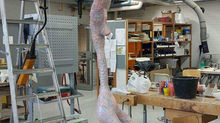'Haliurunnae'
- Aneta Atsova
- Feb 22, 2017
- 2 min read
Updated: Nov 3
Dimensions: 65 x 47 x 31’’
Materials: Paper pulp, acrylics
The sculpture draws on the legend of the Haliurunnae, women accused of witchcraft in Gothic tradition. Built upon a wooden branch, the figure depicts a woman tied to a tree, stripped of clothing, and poised for a ritualistic act. The red hair signifies witchcraft and transgressive power, while her relaxed posture and serene expression challenge conventional associations of sin with remorse. The work references Norse seiðr practices, Balto-Finnic shamanic traditions, and Gothic mythologies, exploring historical perceptions of female power, ritual, and societal judgment.
Femininity
‘In some accounts, as in the prototypical genesis story, that of Adam and Eve, in some Medieval Islamic accounts of Sarah and Hagar, the Saxon origin story told by Widukind of Corvey, or the story of the Lombard hero Alboin, women are the source of sin and conflict. In the Aeneid Dido, founder of Carthage, is at the heart of the conflict with Aeneas and thus, ultimately, responsible for the disastrous fate of her city. But there are other, more complex women: magical women such as Gambara, mother of the first Lombards, and Libuse, Kazi, and Tethka, the three magical sisters in Cosmas of Prague’s account of the origins of the Czechs; women who engender races of monsters by consorting with demons such as Lilith, and the Gothic Haliurunnae from whom sprang the Huns; saintly women like Clothild or Dubrovca who were responsible for converting their husbands and thus their peoples in the tradition of St. Helen. There were monstrous women like the mother of the Scyths in Herodotus, or Melusine who were part serpent part human. And there was Mary, in the Jewish tradition a fallen woman who foisted off her bastard child by a Roman soldier on her gullible husband, in Islam, “above the women of all created beings”, and in Christianity the Mother of all faithful. The representations of women in stories of beginnings, as Amazons or saints, monsters or troublemakers, are too complex to categorize. Whenever they appear, women are problematic and contradictory figures.’
Patrick Geary ‘CUR IN FEMINAS TAMDIU PERSEVERAT?’
Vienna, 2004





































Comments